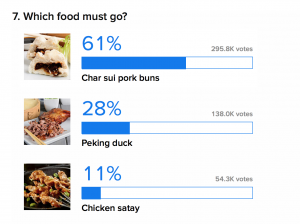The goals of BuzzFeed quizzes depend on which of the four categories the specific quiz falls into. According to the BuzzFeed Article, Everything You Need to Know About Creating a BuzzFeed Quiz, there are only four types of quiz. The quiz that I wrote about in my other blog post, fell under the category “Poll”. The other three types of quiz’s found on BuzzFeed are Trivia, Personality, and Checklists.
Formal elements of Polls include the following: only picking one answer choice, your choice immediately being recorded (unlike other quizzes where you can change answer choices until you submit it all at the end), pictures with each answer choice (incase someone doesn’t know what something is), showing the % of everyone who has taken it, and a specific theme throughout the poll itself.
Trivia quizes have only one correct answer, because it is asking about specific facts or events. An example of this quiz would be the BuzzFeed Quiz, “The Hardest Food Quiz You’ll Ever Take”.
In personality quizzes, the most popular types of quizzes found on BuzzFeed, people choose answers and are assigned the “personality” at the end of the quiz that fell under the category they chose the most choices in. An example of this relating to rhetoric of food would be the quiz, “Your Food Preferences Can Tell us Exactly Which Decade You Belong In”. In personality quizzes, the audience can retake this quiz as many times as they want to get different answers.
In Checklist Quizzes, the audience is asked to check off how many of these things they have eaten (in food related quizzes). Other common examples would be how many of these TV shows they have seen, How many songs they know, etc. At the end, the quiz tells you how much % you have eaten or whatever it is they are asking and often gives a witty comment afterwards. An example of this quiz, is “How Many Kinds of French Fries Have You Actually Eaten?”
In my final paper, I plan to go more into detail on the sub-genre of Poll Quizzes, and also expand on the elements that make up the quiz categories of Trivia Quizzes, Personality Quizzes, and Checklist Quizzes.
The Texts that I will be using in my paper are the following:
https://www.buzzfeed.com/ariellecalderon/buzzfeed-quiz-guide?utm_term=.ud6lPEny0#.mwrRYPp8j
Trivia: https://www.buzzfeed.com/alexfinnis/what-is-your-food-iq?utm_term=.qqnBm4156#.vdqlXB8xQ
Personality: https://www.buzzfeed.com/javieraceves/we-can-guess-what-decade-you-really-belong-to-with?utm_term=.du41adxP4#.ukvDRaBv3
Poll: https://www.buzzfeed.com/hattiesoykan/which-potato-must-go?utm_term=.hu33gYzoR#.fr093RE8G
Checklist: https://www.buzzfeed.com/jeanlucbouchard/how-much-do-you-love-french-fries?utm_term=.llKbPMGkl#.vq2np2eoY
Do you think that for my final project, I should create a quiz in each of the four categories? I originally was just going to create a poll but I think that it would be more beneficial to create each of the different types of quizzes.
